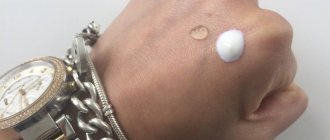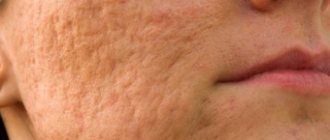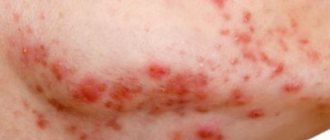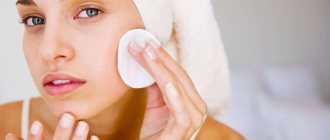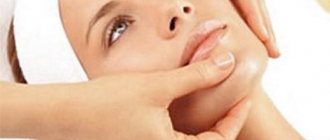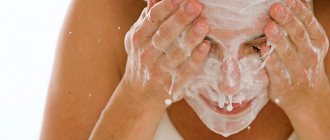What is the difference: home peeling and peeling at a cosmetologist
Peels that can be used at home do not penetrate deeply into the skin and give an unnoticeable result, but they certainly help maintain an even tone and healthy skin. Chemical peels performed by estheticians have a lower pH level than at-home peels, so they can penetrate much deeper into the skin and target skin problems such as hyperpigmentation and acne. Chemical peels can cause redness of the skin; a recovery period will last for several days, during which the “old” skin will gradually peel off and renewed skin will appear.
Chemical peeling performed by cosmetologists will be much more effective for your skin than peeling at home.
Review of cosmetic products for superficial peeling
A list of effective drugs for superficial exfoliation is highlighted:
- Absolue Precious Cells from Lancome. Evens out skin tone, eliminates wrinkles and exfoliates dead cells. Ingredients: flaxseed extract, salicylic, glycolic and fruit acids.
- Biosource from Biotherm. The gel-like consistency effectively exfoliates the stratum corneum of the skin and is suitable for any type of epidermis.
- Nightly Refining Micro Peel Concentrate from Kiehls. Peeling, which is applied before bedtime, activates the regeneration process at the cellular level. Contains fruit acids and quinoa extract.
- Double Glow from Vichy. A mask with abrasive particles and fruit acids evens out the color and texture of the dermis and cleanses clogged pores.
- Blemish+Age Defense from ScinCeuticals. Cleansing serum with salicylic, dioic, citric and glycolic acids. Helps restore the elasticity of the epidermis, get rid of expression lines and shallow age wrinkles.
- Pure Ritual from HR. The product contains glycolic acid and black rice extract, helps to deeply cleanse the skin.
Contraindications:
- The procedure is not recommended for pregnant and lactating women;
- When taking medications based on isotretinoin;
- For herpes and skin diseases;
- When taking antibiotics;
- For oncological diseases;
- For open wounds.
After a chemical peel, the skin is more sensitive to sunlight, so after the procedure it is necessary to use sunscreens and products.
Before the procedure, the cosmetologist must take into account many factors and ask all the necessary questions so that the procedure is as comfortable as possible for the client and gives the best result with the fewest possible side effects.
What is superficial peeling
Chemical surface cleansing is aimed at removing the stratum corneum of the dermis - this helps to even out the complexion and cleanse the pores of impurities. This type of peeling is characterized by a rejuvenating, exfoliating and brightening effect on the skin.
Mechanism of action
The acids and alkalis included in the cleanser lead to the activation of metabolic and regeneration processes, and also stimulate the natural production of collagen fibers.
How is peeling performed and what should you pay attention to after the procedure?
Before the procedure, the skin is cleansed and “degreased”. During the procedure, you will feel warmth and burning on the treated skin surface. To reduce discomfort, you can use a fan or local anesthetic. After peeling, first of all, take care of protecting your skin from the sun, so it is not recommended to carry out the procedure at the height of summer or before leaving for warm countries.
After peeling, you will feel tightness and slight dryness of the skin. The skin may remain red for an hour after the procedure. The condition of the skin in the post-peeling period depends on the type of skin and the type of peeling performed.
It is recommended to avoid excessive physical activity and excessive sweating for several days after the procedure. Do not rub the treated skin area after peeling. Do not use retinol or AXA products for at least 10 days after peeling. Avoid visiting the sauna or bathhouse for several days.
Types of superficial peeling
Superficial cleansing is divided according to the method of impact on the epidermis and is selected taking into account age, sensitivity and the initial state of the epidermis.
Mechanical
Removal of the dead skin layer is carried out using abrasive particles included in the preparation or a professional metal brush. In the case of vacuum exfoliation, clogged pores are cleared of impurities using negative pressure.
Hardware
This category includes laser, diamond and ultrasonic cleaning, as well as fractional photothermolysis performed by a special laser.
Chemical
This type of peeling is divided into several subtypes:
- Enzymatic. The active substance is plant or animal enzymes that have a gentle effect on the skin, cleansing it of dead cells and dirt. Allowed to be used to cleanse all types of skin.
- Acid. The cleansing solution contains lactic, salicylic, glycolic or various fruit acids - it slows down the aging process, eliminates facial wrinkles, and has a whitening effect.
- Combined. Cleaning is performed with enzymes and AHA acids.
It is the most popular type of exfoliation, as it allows you to achieve a positive result without damaging the healthy dermis in the shortest possible time.
Superficial chemical peeling of the face: technique, rehabilitation period and customer reviews
To effectively cleanse facial skin and prevent the first signs of aging, a gentle method is used - superficial peeling. Reviews of chemical peeling posted on the Internet allow you to verify that you have obtained the desired cosmetic effect. Let's talk about what superficial skin peeling is, what types it comes in, how and where superficial facial skin cleansing is performed, what the effect of the procedure is, what advantages it has, and we will also look at the features of the rehabilitation period.
Superficial chemical peeling is a universal procedure that is suitable for any skin type. The main purpose of superficial chemical peeling is to gently cleanse the upper layers of facial skin.
A distinctive feature of the technique is that a mild chemical or mechanical effect is applied to the skin of the face. The chemical compounds used within the technique act exclusively on the upper layers of the skin. The penetrating ability of the active composition allows you to cleanse the skin of impurities and minor dermatological defects.
Reviews posted on forums about superficial facial peeling make it possible to verify that the procedure helps even out the tone of the face and restore elasticity and youth to the skin.
As part of the application of surface peeling, acid-base compounds are used. The effect of active components on the upper layers of the epidermis allows you to activate cell regeneration processes and create conditions for the production of collagen, which gives the skin elasticity.
In a beauty salon, superficial peeling is either an independent cosmetic procedure or is part of a complex of facial and body skin care procedures. After superficial peeling, up to 14 days are allotted for the recovery period. This cleansing technique can be used in the following cases:
- The presence of problem areas on the face - pigmentation zones, uneven complexion;
- The appearance of the first signs of aging on the skin and a tendency to the appearance of inflammatory elements;
- Uneven skin microrelief;
- Enlarged facial pores;
- Photoaging;
- As a preparation stage for medium or deep peels.
In order for superficial chemical peeling of the face to bring the required cosmetic effect, you need to complete a course of 4-10 procedures.
This cleansing technique is highly effective - in 90% of cases it is possible to even out the color and microrelief of the skin, reduce fine wrinkles, get rid of post-inflammatory pigmentation and other defects.
Compared to superficial cleansing, superficial-medium peelings imply deeper penetration of acid-base compounds. The rehabilitation period after such procedures lasts much longer.
However, there are certain restrictions for such cosmetic procedures:
- During pregnancy and breastfeeding;
- The presence of aggravated herpes and active inflammatory processes on the skin;
- Allergy to components in cleansers;
- The presence of fresh lesions on the skin - wounds, abrasions, smudges, etc.;
- Having a fresh tan from the sun or after visiting a solarium.
The face after superficial peeling looks fresh and rejuvenated. Depending on the indications and the required cosmetic effect, the use of one of the following types of surface peeling may be recommended:
- Mechanical cleaning. The basis is cleansing scrubs and a device with a vacuum mechanism. Due to the application of negative pressure, the layers of the epidermis are cleared of clogged pores and excess fat;
- Hardware cleaning. The procedure is performed using a laser or ultrasonic facial peeling. Laser facial peeling is highly effective as a means of preventing and combating age-related skin changes;
- Chemical cleaning. Here, acid-base compounds with penetrating ability are taken as the basis. The use of the technique allows you to cleanse the skin of impurities, even out the tone and activate tissue regeneration processes.
Chemical peeling of the skin is most often used. After using such peelings, the result is noticeable after the first visit to a cosmetologist. The following formulations can be selected for chemical peeling:
- Enzyme peelings. They have a minimum number of contraindications and are suitable even for sensitive skin;
- Acidic cleaners. Effective for preventing signs of aging, combating traces of pigmentation;
- Combined peelings. They contain acids and enzymes, which allows not only to eliminate skin defects, but also to enhance metabolic processes in the surface layers of the epidermis.
The selection of acids for the cleansing procedure is carried out individually, taking into account the indications and the possible presence of allergies to individual components. Each acid differs in its penetrating and cleaning ability and has a different effect on a specific skin type. For example, glycolic acid can be used to cleanse combination skin, and retinoic acid can be used to eliminate signs of aging, etc.
The protocol for conducting superficial chemical peeling is presented in the following stages:
- Preparatory stage. The skin is completely cleansed of traces of makeup and impurities using a gel and cleansing toner;
- Main stage. A cleansing composition is applied to the prepared facial skin using cotton pads or a gentle massage with your fingers. The number of layers and exposure time of the composition varies, depending on a number of factors;
- Neutralizing stage. A neutralizing composition is applied to the skin of the face, which stops the action of the acid;
- The final stage. Here you wash your face, apply a nourishing cream mask to the skin, and then finish with cream.
As a rule, after the cleansing procedure, peeling may appear on the skin. Therefore, during the rehabilitation period, it is recommended to use an integrated approach to skin care:
- Use moisturizing creams recommended by a cosmetologist;
- Do not use scrubs and similar products for 1-1.5 months;
- During periods of solar activity, use sunscreen sprays and creams;
- Use products with moisturizing effects when washing your face;
- Avoid using alcohol-containing products to treat facial skin;
- Make restorative masks at least 3 times a week.
Peeling and redness of the skin after cleansing usually disappear within 7-14 days. To combat these phenomena, it is recommended to use creams based on panthenol and other soothing ingredients.
Superficial peeling is an effective procedure for preventing and combating age-related skin changes. This facial cleansing is carried out in a salon using hardware or chemical effects on the skin. To obtain the required cosmetic effect, you should complete a course of 3-10 procedures. It is better to entrust the choice of peeling to a cosmetologist who will assess the condition of your skin and offer the best solution. You can do acid peels at home, but not all of them. Do not forget about proper post-peeling care and follow all doctor’s recommendations.
Did you like the article? Share with your friends!
How is the procedure done?
All makeup is removed from the surface of the skin, after which it is treated with an antiseptic. Before applying the acid, you put special glasses on your eyes and apply Vaseline on your lips. The acid is applied to the skin in a thin layer using a brush, swab or piece of cotton wool. The acid is applied to the face from top to bottom: first on the forehead, then on the cheeks and then on the chin. A fan is used to cool the face and reduce burning. The acid must be applied to the skin of the face for a strictly defined amount of time. A cosmetologist or doctor who performs chemical skin cleansing always has a timer that goes off when the time for which the acid should have been on the skin expires. After the timer rings, the acid is immediately washed off with clean water. If the patient feels a burning sensation in some areas of the skin, they are wiped again with clean water.
The effectiveness of the procedure: reviews, photo results
Reviews, videos and photos before and after various types of superficial facial peeling:
I cleaned my face three times using salicylic acid. As a result, the skin became smooth, radiant, and signs of acne disappeared. Wrinkles are now not as noticeable as they were before.
Alina, 25 years old
When the procedure was done the first time, the results were not immediately noticeable. After peeling, the situation changed. I managed to get rid of acne that was present on my skin. After completing the full course, the scar on the face disappeared, the face no longer gives the impression of being dull.
Ekaterina, 31 years old
